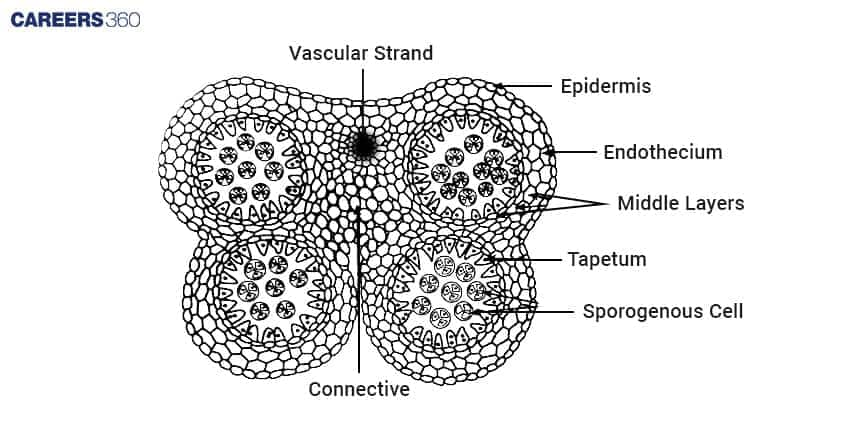Dithecous Anther: definition, meaning, diagram, Structure, Formation
The anther is an important part of the male reproductive organ in flowering plants known as the stamen. By definition, the anther is a structure that produces and releases the pollen grains, which are necessary for fertilisation. In terms of meaning, it represents the pollen-bearing portion of the stamen, typically located at its tip. A typical diagram of an anther shows it has a bilobed structure, each lobe containing two pollen sacs.
This Story also Contains
- Structure of Dithecous Anther
- A Transverse Cross-Section of Dithecous Anther
- Formation of theca in Dithecous Anther
- Function of the Dithecous Anther
.jpg)
The structure of the anther is highly specialised, comprising layers, such as the epidermis, endothecium, middle layers and tapetum, all of which support the pollen formation. The process begins with the differentiation of microspore mother cells within the pollen sacs, which undergo meiosis to form haploid microspores that develop into pollen grains. A detailed study of anther can be studied in the biology subject.
Structure of Dithecous Anther
Anther is that part of the stamen which bears pollen, composed of pollen sacs where the production of pollen grains takes place.
Comparison between monothecous and diothecous anthers
If one theca is present on the anther, it is called monothecous, and if two thecae are present, then the condition is known as dithecous; each theca has two pollen sacs.
Theca Structure
The theca structure of a dithecous anther is described below-
Dithecous anther means it has two thecae or lobes.
Each theca contains two microsporangia, so a dithecous anther has four pollen sacs in total.
The theca are separated by a connective tissue, which is a part of the filament and contains vascular bundles.
The two thecae are usually parallel and symmetrical.
The dehiscence of the theca occurs through longitudnal slits, allowing pollen grain to be released.

Also Read-
A Transverse Cross-Section of Dithecous Anther
The transverse cross-section of dithecous anther is explained below-
The epidermis is the outermost protective layer of the anther.
The endothecium lies just beneath the epidermis and helps in the dehiscence of the anther by developing fibrous thickening.
There are 1-3 layers beneath the endothecium, which degenerate during pollen maturation.
The tapetum is the innermost nutritive layer, which surrounds the microsporangia and is rich in cytoplasm and provides nourishment to developing pollen.
The microspore has four pollen sacs, two in each theca, where microspore mother cells undergo meiosis to form microspores.
The central sterile tissue, which is the connective tissue, joins the two thecae and contains vascular bundles for nutrient supply.
Formation of theca in Dithecous Anther
The process of formation of theca in dithecous anther is given below-
A mature dithecous anther has two thecae (lobes), each containing two microsporangia, making a total of four microsporangia.
The anther develops from a mass of meristematic tissue surrounded by an epidermis. It becomes bilobed as it matures.
As development continues, each lobe or theca is separated by a connective tissue, which contains vascular bundles for nutrient transport.
Within each theca, two microsporangia form, where pollen (microspores) will later develop through meiosis.
Each microsporangium is surrounded by four wall layers—epidermis, endothecium, middle layers, and tapetum—which support pollen development.
In the mature dithecous anther, the two thecae lie side by side, and dehiscence occurs along the line of junction to release pollen grains.
Function of the Dithecous Anther
The functions are given below:
Pollen Production: Each theca contains two microsporangia that produce microspore mother cells, which undergo meiosis to form pollen grains.
Pollen Storage: The theca serves as a protective chamber where developing and mature pollen grains are stored until they are released.
Pollen Maturation: The internal environment of the theca, which has a layer of tapetum, helps in the nourishment and maturation of pollen.
Pollen Release (Dehiscence): The theca participates in anther dehiscence, where the walls split open to release pollen grains for pollination.
Reproductive Role: The theca ensures the successful transfer of male gametes (via pollen) to the female part of the flower during fertilisation.
Also Read-
Recommended video on "Dithecous Anther"
Frequently Asked Questions (FAQs)
Plant examples with dithecous anther types are the lily, rose, and other flowering plants. This dithecous structure in such plants helps in the optimum production and dispersal of pollen grains.
The dithecous anther plays a crucial role in producing and liberating huge quantities of pollen grains for the process of pollination. This pollen is further transferred to the stigma of flowers by wind, insects, or other kinds of pollinators, hence promoting fertilization and seed formation.
A dithecous anther bears two thecae with two pollen sacs in each, hence there are four locules altogether. While a monoecious anther is one in which there is a single theca, inside it has two pollen sacs, hence two locules.
The thecae in a dithecous anther contain the pollen sacs wherein the pollen grains are produced. Their critical function is for the protection of the developing pollen and its release while dehiscence.